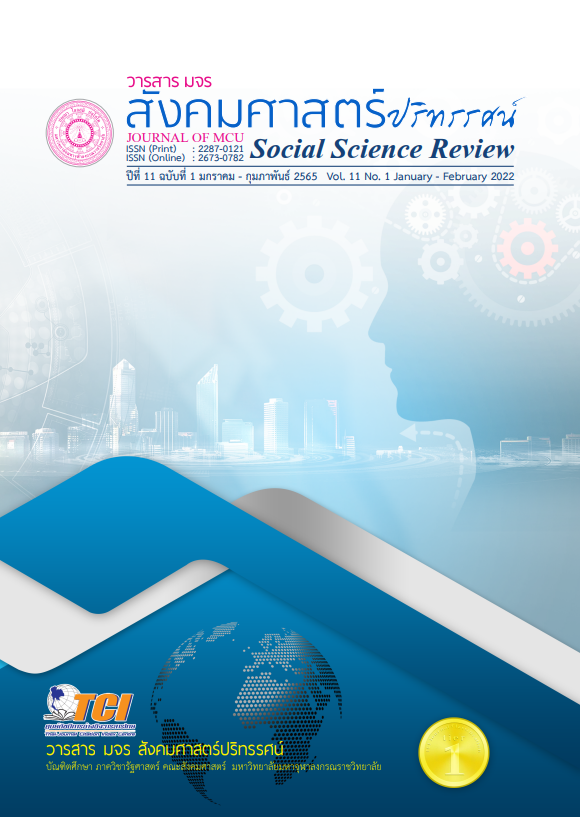รูปแบบการบริหารจัดการสุขภาวะพระสงฆ์ตามธรรมนูญสุขภาพ พระสงฆ์แห่งชาติ ของพระสังฆาธิการในจังหวัดพิจิตร
คำสำคัญ:
ธรรมนูญสุขภาพพระสงฆ์แห่งชาติ, การบริการจัดการสุขภาพ, พระสังฆาธิการบทคัดย่อ
บทความวิจัยนี้มีวัตถุประสงค์เพื่อนำเสนอรูปแบบ เป็นการวิจัยแบบผสานวิธีระหว่าง การวิจัยเชิงปริมาณ สุ่มตัวอย่างแบบชั้นภูมิ ได้กลุ่มตัวอย่าง จำนวน 395 รูป เก็บข้อมูลด้วยแบบสอบถาม วิเคราะห์ข้อมูลด้วยโปรแกรมทางสังคมศาสตร์ และการวิจัยเชิงคุณภาพ เลือกแบบเจาะจง ผู้ให้ข้อมูลสำคัญ 18 รูปหรือคน เก็บข้อมูลด้วยการสัมภาษณ์เชิงลึก และการสนทนากลุ่มเฉพาะจำนวน 10 รูปหรือคน วิเคราะห์ข้อมูลด้วยเชิงพรรณนา
ผลการศึกษาพบว่า รูปแบบการบริหารจัดการ ประกอบด้วย 1.ด้านระบบบริหาร สร้างระบบการเรียนรู้เพื่อสร้างบุคลากรให้ความรู้เท่าทัน ด้านสุขภาพของพระสงฆ์ 2. ด้านกำลังคนด้านสุขภาพ มีการส่งเสริมพระสงฆ์ภายในวัดของท่านที่มีความรู้ ความเข้าใจในระบบบริการสาธารณสุข 3. ด้านข้อมูลข่าวสาร มีการจัดการระบบการสื่อสารด้วยเทคโนโลยี 4. ด้านเทคโนโลยีทางการแพทย์ มีการสนับสนุนให้พระคิลานุปัฏฐากมีความรู้ 5. ด้านค่าใช้จ่ายด้านสุขภาพ มีการประสานงานกับองค์กรปกครองส่วนท้องถิ่น และชุมชน เพื่อการดำเนินงานด้านการสร้างเสริมสุขภาพ 6. ด้านภาวะผู้นำและธรรมาภิบาล มีการเปิดกว้างให้สังคมและชุมชน เข้ามามีส่วนร่วมในการสร้างสุขภาวะ 7. ด้านระบบสุขภาพชุมชน มีการประสานงานเครือข่ายพระสงฆ์เพื่อสังคม รวมถึงเครือข่ายองค์กรทางพระพุทธศาสนาอื่น ๆ
เอกสารอ้างอิง
ณัฐวดี จิตรมานะศักดิ์. (2556). พฤติกรรมส่งเสริมสุขภาพสำหรับพระสงฆ์. วารสารวิทยาศาสตร์ และเทคโนโลยีมหาวิทยาลัยราชภัฏพระนคร, 3(3), 8.
พระมหากฤษฎา กิตฺติโสภโณ. (2561). เทคนิคการใช้สถิติเพื่อการวิจัย. พระนครศรีอยุธยา: มหาจุฬาลงกรณราชวิทยาลัย.
พระมหาอภิวัชร์ อภิวชฺชโร. (2564). คุณภาพชีวิตของประชาชนตามแนวโครงการหมู่บ้านรักษาศีล 5 ของชุมชนหนองจอก อำเภอท่ายาง จังหวัดเพชรบุรี. วารสารสหวิทยาการนวัตกรรม, 4(2), 46-60.
พระราชสิทธิเวที (วิรัช วิโรจโน). (2562). การวิเคราะห์สถานการณ์สุขภาวะตามหลักภาวนา 4 ของพระสงฆ์ในจังหวัดพิจิตร. วารสาร มจร สังคมศาสตร์ปริทรรศน์, 8(3), 15-16.
พระเอกลักษณ์ อชิตโตและคณะ. (2564). เครือข่ายพระสงฆ์สาธารณะสงเคราะห์ของหลวงพ่อแดง นนฺทิโย: กับการช่วยเหลือประชาชนในพื้นที่น้ำท่วมจังหวัดชัยภูมิ นครราชสีมา พระนครศรีอยุธยา. วารสารพุทธนวัตกรรมและการจัดการ, 4(2), 57-68.
มหาจุฬาลงกรณราชวิทยาลัย. (2539). พระไตรปิฎกฉบับภาษาไทย ฉบับมหาจุฬาลงกรณราชวิทยาลัย. กรุงเทพฯ: โรงพิมพ์มหาจุฬาลงกรณราชวิทยาลัย.
สำนักงานคณะกรรมการสุขภาพแห่งชาติ (สช.). (2560). ธรรมนูญสุขภาพพระสงฆ์แห่งชาติ พุทธศักราช 2560. นนทบุรี: บริษัท โอ.เอส. พริ้นติ้ง เฮาส์ จำกัด.
ดาวน์โหลด
เผยแพร่แล้ว
รูปแบบการอ้างอิง
ฉบับ
ประเภทบทความ
สัญญาอนุญาต
ลิขสิทธิ์ (c) 2022 วารสาร มจร สังคมศาสตร์ปริทรรศน์

อนุญาตภายใต้เงื่อนไข Creative Commons Attribution-NonCommercial-NoDerivatives 4.0 International License.
เพื่อให้เป็นไปตามกฎหมายลิขสิทธิ์ ผู้นิพนธ์ทุกท่านต้องลงลายมือชื่อในแบบฟอร์มใบมอบลิขสิทธิ์บทความให้แก่วารสารฯ พร้อมกับบทความต้นฉบับที่ได้แก้ไขครั้งสุดท้าย นอกจากนี้ ผู้นิพนธ์ทุกท่านต้องยืนยันว่าบทความต้นฉบับที่ส่งมาตีพิมพ์นั้น ได้ส่งมาตีพิมพ์เฉพาะในวารสาร มจร สังคมศาสตร์ปริทรรศน์ เพียงแห่งเดียวเท่านั้น หากมีการใช้ภาพหรือตารางหรือเนื้อหาอื่นๆ ของผู้นิพนธ์อื่นที่ปรากฏในสิ่งตีพิมพ์อื่นมาแล้ว ผู้นิพนธ์ต้องขออนุญาตเจ้าของลิขสิทธิ์ก่อน พร้อมทั้งแสดงหนังสือที่ได้รับการยินยอมต่อบรรณาธิการ ก่อนที่บทความจะได้รับการตีพิมพ์ หากไม่เป็นไปตามข้อกำหนดเบื้องต้น ทางวารสารจะถอดบทความของท่านออกโดยไม่มีข้อยกเว้นใดๆ ทั้งสิ้น





